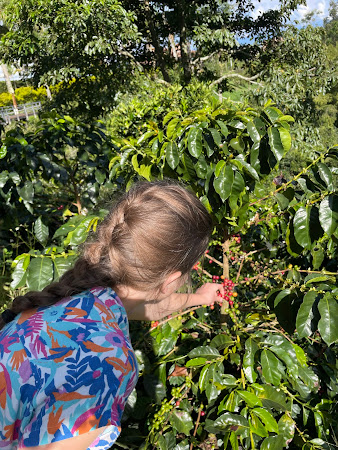Did you know that Colombia is one of the places that produces the most coffee in the world? Here are some interesting facts about how they do it.
We are staying on a coffee farm, and the coffee harvesting season is just being wrapped up. The typical harvest last two months. During the harvest, the farmers hire coffee pickers to pick the coffee berries off plants. When the coffee fruit is ripe and ready to be picked, it is dark red. The fruit around the coffee bean tastes sweet and juicy. When you eat it, you eat the flesh off the bean, not bean itself.
 |
| The coffee field that we can see from our porch |
 |
| Me picking ripe coffee fruit to taste |
 |
| A bag of coffee berries collected that day |
 |
| A worker getting what he collected weighed |
Coffee pickers are paid based on the weight of coffee they pick. When they are done collecting for the day, they hang their bags on a scale to see how much money they will get. They get paid 1,200 pesos per kilogram they pick. Today, this is about $0.28 for every 2.2 lbs. This worker had a good day and collected 68 kilos, earning about $19.00.
 |
| The machine that separates the shells from the beans |
Coffee is made from the seeds of the fruit. To separate the seeds from the fruit, they pour the fruit into the top of this green machine. The seeds come down the chute. There are two seeds from each berry.
 |
| Where seeds are washed and sorted |
After the coffee beans are separated from their shells, they are washed. Then they are sorted into good quality, and acceptable quality. They can tell the difference because when they wash the beans, the good quality beans sink and the acceptable quality beans float.














It's interesting how they keep the lesser quality beans for themselves! There probably isn't as much of a demand to buy them.
ReplyDeleteWhat do the undried coffee beans taste like?
I didn't taste one because I don't think that would be very yummy.
DeleteI love coffee! This was super fun! Did you enjoy your coffee with cream and sugar?
ReplyDeleteI kind of liked it.
DeleteMaria - another great blog entry. I think I need a cup of coffee. Thanks for posting.
ReplyDeleteI would absolutely love to experience a tour of a coffee farm like you have. Adding to my bucket list.
ReplyDeleteAlso, this is a much cooler way to learn than being in school! ;) I hope you are enjoying it!
Maria, great blog. It was very informative and the pictures were great. What is done with the red flesh after it is removed? Some people think it is healthy to eat. Reading this has made me think I can actually smell the coffee. Oh wait I really do actually smell the coffee, I'm going to have my morning coffee right now.
ReplyDeleteI like to eat the fruit! I can feel a little caffeine buzz just from A single one! They are a little sweet and bitter. I think the majority of the fruit is conposted
DeleteAunt Linda. Maria, thanks so much for all the info! Now I know a few more interesting things besides it is tasty and keeps a person awake.
ReplyDeleteHow cool to see the process of making coffee from the experts. Tell your family hi!
ReplyDeleteWow! I did not know that much about coffee. Love Savannah
ReplyDeleteThis is so cool! We had no idea of what the coffee bean process entailed. VERY interesting! Your blog is fabulous! You are an excellent writer and capture things of interest so well! (We see your Dad's comment above regarding the fruit, which we were curious about also.) Thank you again, so much, for writing these and giving us all such great 'snapshots' of your awesome adventures, dear Maria! We love you and are eager to hear more! ~Grandpa & Nana-Carol
ReplyDeleteP.S. It looks so warm and lovely there. It is 6 degrees out as I type this, with -12 degrees expected tonight.
Great blog!
ReplyDelete